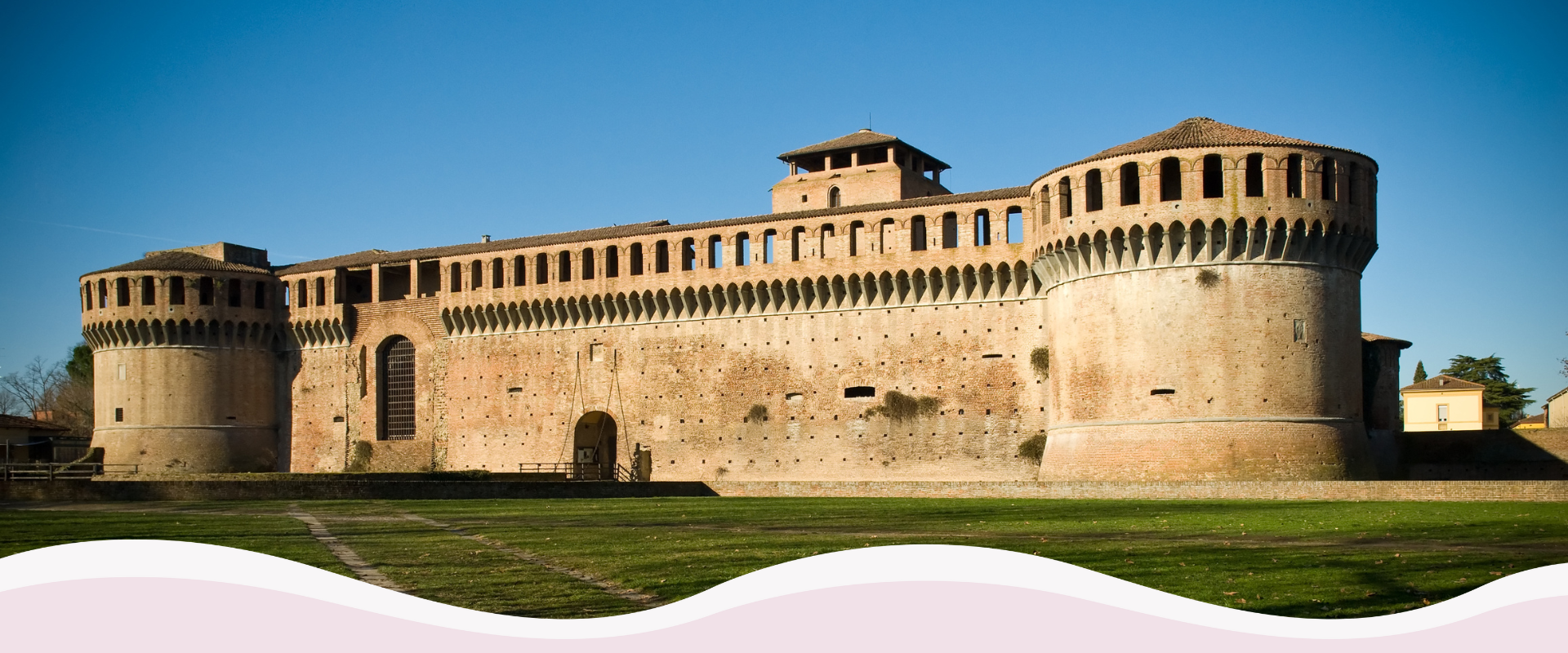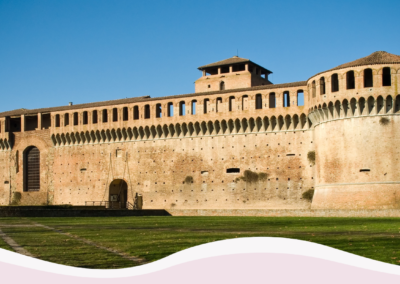Cool Noons Project: Rethinking Imola’s Urban Climate for Residents and Visitors
Exploring Imola’s Climate and Tourist Landscape
Imola is a city in the heart of the Emilia-Romagna region. Here centuries-old history harmoniously coexists with forward-thinking innovation. Known for its rich cultural heritage, Imola is home to architectural gems such as the Sforza Fortress and the San Cassiano Cathedral, alongside the world-renowned Autodromo Enzo e Dino Ferrari, which continues to attract motorsport enthusiasts from across the globe.
From a touristic point of view, Imola offers a unique blend of medieval charm, green landscapes, and vibrant local traditions. Its location along the Santerno River and proximity to the Tuscan-Romagna Apennines make it an ideal destination for visitors seeking both historical exploration and outdoor experiences.
However, from a climatic point of view, Imola experiences hot, dry summers with temperatures frequently exceeding 35°C, particularly during heatwaves. These conditions, intensified by urban heat island effects, pose challenges to public health and quality of life, especially for vulnerable populations.
Imola’s specific microclimatic conditions and urban structure highlight the need for effective cooling interventions, positioning the city as a key testing ground for the innovative solutions proposed by the Cool Noons project.
Imola’s Climate Challenge: Adapting to Increasing Heat
In Imola, summer temperatures are steadily increasing, often reaching uncomfortable or even dangerous levels, particularly during the central hours of the day. The city’s location in the Po Valley and urban layout, with dense buildings and limited natural shade in some areas, contributes to heat accumulation and low wind circulation. This affects daily life for residents and reduces the attractiveness of the city for summer tourists, who may choose to travel elsewhere or avoid visiting during the hottest months.
Adapting to this new climate reality requires urgent and specific solutions. How can cities like Imola respond rapidly and effectively? How can we make urban spaces more livable during the hottest hours of the day? The Cool Noons project offers a collaborative answer to these questions. By leveraging the expertise of its diverse network of partners, the project shares, develops, and applies innovative strategies to enhance thermal comfort and support the resilience of Mediterranean urban tourism.
Rethinking Urban Comfort for a Resilient Tourism Future
The Cool Noons project aims to develop an integrated strategy and action plan to help Mediterranean cities, like Imola, adapt to the challenges of extreme summer heat. The goal is to improve the experience of both residents and visitors by making cities more livable and welcoming even during the hottest months.
In Imola, Cool Noons focuses on realistic, feasible, and rapid interventions that can be directly applied within the urban environment. Across the five pilot cities—Lisbon, Marseille, Imola, Dubrovnik, and Budva—the project tests and implements a wide range of solutions. These include nature-based approaches such as revegetation and shaded rest areas, the installation of water features, the use of light-colored materials to reflect heat, and the creation of new public spaces. While some strategies have already proven effective, others emerge directly from the ideas and needs of residents and visitors.
With Cool Noons, Imola is contributing to a shared Mediterranean vision: cities that are better prepared for the future climate, and more enjoyable for everyone who lives in or visits them.
Practical Solutions to Beat the Heat
Solution 1: New water fountains – Four locations where new fountains will be installed to provide cool and comfortable areas.
- 1 fountain in Medaglie d’Oro square: railway station
- 1 fountain Leonardo da Vinci square
- 2 fountains Sforza Fortress
Each city mapped at least two paths, chosen based on tourist interest and optimal thermal comfort. In defining the routes, the Municipality of Imola chose to focus on the historic city center and its surrounding urban areas, building on the city’s climate mitigation and adaptation strategy centered around urban green infrastructure and sustainable mobility. In collaboration with the Municipality and the professionals involved, a network of three paths was developed, each crossing the city center with a length of approximately 2 kilometers. Key starting and ending points for all routes are the train station and the Autodromo Enzo e Dino Ferrari racetrack, ensuring easy access while connecting important local attractions and cooler, greener urban spaces.
Solution 2: Trees replacement and planting – Intervention in two areas of the city to replace and plant new trees.
Interventions in two areas of the city center:
- Replacement of no. 2 trees species at Gramsci Square.
- Supply and planting of no. 3 trees at Aurelio Bernabè Garden – Piazzale Michelangelo (near high school)
Trees bring multiple benefits to urban environments beyond providing shade. By replacing and planting new trees in key areas of Imola’s city center, this solution helps reduce surface and air temperatures, improves air quality, and enhances biodiversity. Trees also create inviting green spaces that encourage people to spend more time outdoors, contributing to both thermal comfort and the overall well-being of residents and visitors. These interventions are vital steps toward transforming Imola’s urban fabric into a cooler, healthier, and more attractive environment.
Solution 3: Pic-Nic tables – Installation of two new picnic tables.
Installation of No. 2 new picnic tables at Piazzale Michelangelo Buonarroti, in an area outside of a school. The two benches will have the following features:
- 1 picnic table 6-seater
- 1 picnic table 4-seater
Public spaces in Imola are experienced and used differently by residents and visitors, each bringing their own perspectives and needs. Recognizing this diversity, the Cool Noons project employs a range of participatory tools to co-design effective cooling solutions. In Imola, this includes workshops and community meetings involving local administration, residents and tourists. Additionally, surveys and questionnaires are conducted directly along the mapped cool paths and key sites to gather firsthand insights into how people use public spaces and what improvements would enhance their comfort and experience during hot days. This collaborative approach helps project partners better understand user behavior and tailor interventions to the real needs of the city’s diverse visitors.
Why Imola Joined Cool Noons and What It Can Achieve
Imola chose to join the Cool Noons project because, although it is not a large or capital city like some of the other partners, its experience is crucial to demonstrating that climate adaptation and urban cooling solutions are essential and achievable for cities of all sizes. Imola’s participation brings valuable insight and visibility to smaller urban centers facing the same heat challenges as larger metropolises.
Through this project, Imola aims to test effective, practical interventions that enhance thermal comfort and improve the quality of life for both residents and visitors. Over the coming two years, Cool Noons will develop and share strategies that strengthen urban resilience against heat, focusing on creating accessible, shaded routes and green spaces that connect key attractions like the historic center and the racetrack.
What if this effort in Imola sparks a wider movement across Mediterranean cities of different sizes and different types of tourism? What if cool paths become green corridors that protect biodiversity, restore soils, and transform urban landscapes? By blending creativity with action and engaging both institutions and citizens, Cool Noons is pioneering a new way to cool cities sustainably.
With Cool Noons, Imola is not just adapting to climate change, it is leading the way in rethinking how cities can become cooler, greener, and more welcoming, starting today with micro-scale projects and innovative paths that transform heat islands into inviting cool zones.



